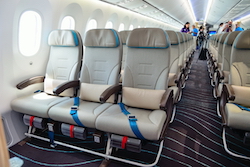New airplane seat cushion testing saves time and money while maintaining safety and increasing comfort
Operators have to change their aircraft’s interior components periodically. In the case of seat cushions this should be every 4-5 years, to maintain safety and comfort. However, there are a number of impediments to doing so this often. Certifications can present problems, requiring complicated tests and/or expensive retrofit programmes. A cushion set alone can cost as much as 600 EUR per person and for those out of production covers, the whole seat must be replaced at twice that cost. Therefore, airlines often delay replacements, with the consequence that passenger comfort and even safety can be compromised. 16gAirTest-Phase2 set out to reduce replacement lead times and costs for both suppliers and end airline customers. It succeeded in doing so by building the capacity to certify a supply of 16g multilayer aircraft seat cushions, using its own newly developed compression test method - instead of the traditional crash testing involving the full seat. An innovation in testing The technique developed by Testori(opens in new window) involved taking the foam composite intended to replace the old cushion and pressing it into the required shape with a specially designed lab instrument. The cylindrical foam, was then subjected to an innovative compression testing technique, developed by the project, which uses a hydraulic device to ascertain the cushion’s resistance to stress conditions during a simulated crash landing. The rules, as laid out by the European Aviation Safety Agency (EASA) stipulate that cushions must be able to withstand frontal forces of 16 g and vertically of 14 g (Certification Specification CS 25.562). Data was collected in a 3-Degrees of Freedom model simulating an aeronautic seat and human body and is able to render information about the forces transferred to passengers’ vertebral columns. The results produced by this mathematical model, developed by at Testori with a partner at the Milan Polytechnic, were then compared to those obtained from the testing of the original cushions, together with the seat through the more time-consuming and costly crash test method. The data allowed the team to demonstrate that their compression testing produced results comparable to those obtained using conventional crash tests. As Mr Giulio Testori explains, “The results showed that the new multilayer foams can be applied directly onto the old seats without any further tests, apart from separate mandatory flammability tests. When refurbishing airplane cushions this innovation could lead to compression testing only the actual foam, instead of having to test the whole seat.” Ending the era of dynamic testing At the request of the EASA(opens in new window) the project team are currently working to further validate the mathematical model and demonstrate its applicability across all categories of seats (business, economy etc.). They are also improving testing, with the aim of getting to the point where dynamic crash testing will be increasingly substituted by testing by simulation, regardless of the variables under consideration. Time and cost savings for airlines translate into more revenue, strengthened competitiveness and company growth, ultimately leading to more jobs. “The benefits of weight loss for aircraft equates to, not only less fuel consumption, but also less CO2 emissions. Being fully compliant with industry standards, these multilayer cushions also can improve passenger comfort, especially during long flights or for those with back or spine problems,” adds Mr Testori.







